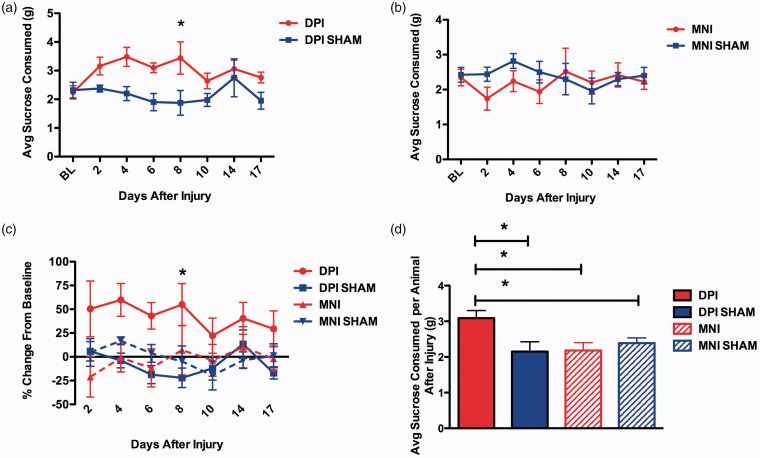Figure 6.
Effect of DPI or MNI on consumption of a 2.5% sucrose solution. Mice were acclimated to the assay and the amount of solution spontaneously consumed during a 2-h test period was measured before and after injury. (a) Group means at baseline (BL) and multiple time points after injury in DPI and DPI sham animals. Animals in the DPI group consumed significantly more sucrose than shams (two-way RM ANOVA: Injury: p = 0.04, F = 6.1, DOF = 1; Time: p = 0.10, (ns); Interaction: p = 0.06 (ns)). Bonferroni post hoc analysis showed a significant increase on Day 8, p < 0.05. (b) Group means at BL and multiple time points after injury in MNI and MNI sham animals. There was no effect of MNI on sucrose consumed (two-way RM ANOVA: Injury: p = 0.5; Time: p = 0.8; Interaction: p = 0.6). (c) Group means of each mouse subjects’ change in sucrose consumption from BL at multiple time points after injury. There was a significant effect of treatment group on sucrose consumption (two-way RM ANOVA: Treatment group: p = 0.04, F = 4.1, DOF = 3; Time: p = 0.3 (ns); Interaction: p = 0.8 (ns)). Bonferroni multiple comparisons post hoc test showed a significant difference between DPI and DPI sham on Day 8 after injury (p < 0.05). (d) Overall group differences showed that the increase in sucrose consumption after injury only occurred in the DPI mice. The average amount of sucrose consumed by mouse at every test date after injury was calculated and the means of the treatment groups compared (one-way ANOVA, p = 0.02, F = 4.3, DOF = 3) Newman-Keuls Multiple Comparison post hoc test showed the DPI group to be significantly different than each of the other treatment groups (p < 0.05). N = 5 mice/group for all data.
DPI: dental pulp injury; MNI: mental nerve injury.

